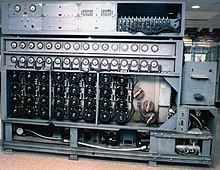National Cryptologic Museum
The National Cryptologic Museum (short: NCM ; German Nationales Kryptologisches Museum ) of the USA deals with the history of cryptography and cryptanalysis . It was opened to the public on 16 December 1993 and is located in Fort Meade in Fort Meade ( Maryland ), a facility of the US armed forces . The National Cryptological Museum is affiliated with the National Security Agency of the USA, the National Security Agency (NSA) , which is in the immediate vicinity.
The museum has around 50,000 visitors from all over the world every year and organizes guided tours for children and young people, whereby the importance of cryptology in the course of history is particularly emphasized and attention is also drawn to the professional opportunities in this field of activity. The museum and an attached open-air exhibition park , the National Vigilance Park , in which, for example, spy planes from the Cold War can be seen, is open to the public with free admission.
Exhibitions
The museum's extensive collection includes thousands of exhibits from the history of cryptography. These include some examples of the Enigma rotor key machine , which was used in communications by the German military during World War II and which was successfully deciphered by allied code breakers . For this purpose, an electromechanical deciphering machine, called the Turing bomb , was used, which was devised by the English mathematician Alan Turing in Bletchley Park, England and further refined by his colleague Gordon Welchman .
American engineers and cryptanalysts managed by Joseph Desch in the United States Naval Computing Machine Laboratory were able to further improve the Turing bomb and significantly increase its speed. The photo shows the American high-speed version of the Turing bomb (internally known as the " Desch bomb "), which reached up to 2000 revolutions per minute, more than fifteen times the speed of its British model, and especially against the four-cylinder Enigma of the German Navy was directed.
Another focus of the museum's exhibition is, of course, the history of American cryptology. Initially started as a kind of "private museum" of the NSA, in the beginning cryptographic exhibits of the NSA were exhibited for their employees. Meanwhile, this collection is a unique testimony of American history on the two areas of cryptography and cryptanalysis grown, with a particular focus on the outstanding American personalities cryptology history, such as the "Father of American cryptology" (Engl .: " Father of American cryptology ”) revered William Friedman , to name just one name from the NSA's Hall of Honor .
Web links
- Official website (English)
- Virtual tour (photos)
Individual evidence
- ↑ John AN Lee, Colin Burke, Deborah Anderson: The US Bombes, NCR, Joseph Desch, and 600 WAVES - The first Reunion of the US Naval Computing Machine Laboratory . IEEE Annals of the History of Computing, 2000. p. 35. Accessed: May 21, 2008. PDF; 0.5 MB ( Memento from February 21, 2007 in the Internet Archive )
- ^ NSA: Cryptologic Almanac - William F. Friedman ( Memento of March 7, 2004 in the Internet Archive ) . Retrieved September 8, 2008.
Coordinates: 39 ° 6 ′ 53.3 " N , 76 ° 46 ′ 29.3" W.



